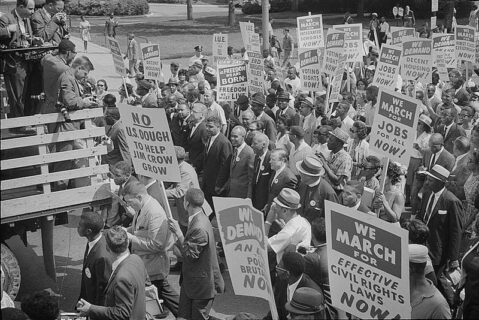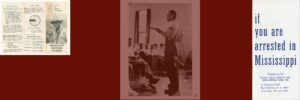
The Civil Rights Act of 1964: A Vindication of Human Dignity
When I was a small child in the late 1950s, my family moved from Greensboro, NC, to nearby Burlington. Though Burlington was our physical home, our hearts remained in Greensboro, where grandmothers and cousins lived and where we could visit our two favorite stores—the Ellis Stone Department Store and F.W. Woolworth’s Five and Dime. My sisters and I liked Ellis Stone because Santa Claus appeared there each Christmas season, and we used the escalator – a miraculous ride for a small boy – to the second floor. There we plopped on Santa’s lap and spilled our Christmas wishes. After we talked to Santa, my father escorted us across the street where we sat at the Woolworth’s Lunch Counter, consuming our favorite meal of grilled cheese sandwiches and chocolate milkshakes.
On Feb 1, 1960, four African American students attending Greensboro’s North Carolina Agricultural and Technical College went to that same Woolworth’s store, purchased several small items, put the receipts in their pockets, and took a seat at that same lunch counter. When they asked for service, the waitress told them it was Woolworth’s policy to serve white people only at the lunch counter.
The four young men, David Richmond, Franklin McCain, Joseph McNeil, and Jibreel Khazan, refused to give up their seats. An African American employee begged them to leave, as did the white store manager. A Greensboro policeman paced behind them, pounding his nightstick into his palm, but the intimidation tactic did not dislodge the students. The quiet dignity these four young men displayed that day spawned a sit-down movement that spread to 55 cities in 13 states and included protests at hotels, beaches, and libraries. As told by Christopher Wilson, in his Smithsonian Magazine piece commemorating the 60th anniversary of the Greensboro sit-down,
“The last person to approach the Greensboro Four on that first day was an elderly white lady, who rose from her seat in the counter area and walked over toward McCain. She sat down next to him and looked at the four students, and told them she was disappointed in them. McCain, in his Air Force ROTC uniform, was ready to defend his actions, but remained calm and asked the woman: “Ma’am, why are you disappointed in us for asking to be served like everyone else?” McCain recalled the woman looking at them, putting her hand on Joe McNeil’s shoulder and saying, “I’m disappointed it took you so long to do this.”
My sisters and I visited Santa each Christmas, munched on our cheese sandwiches, and swallowed our shakes at Woolworth’s, ignorant of the changes that were coming to Greensboro, to North Carolina, and to the South. We were equally unaware of the long-delayed need for change and the long struggle of African Americans to gain political and social equality. My father, on the other hand, was very aware that change was needed. As a deacon in a Greensboro Baptist church, he proposed that the board of deacons issue a statement proclaiming that all races were welcome in their church. He was hopelessly naive. The Sunday following my father’s proposal, the women watching babies in the nursery while their parents attended Sunday School and listened to the weekly sermon refused to watch my sister because she was “that man’s child.” Unfortunately, this experience silenced my father. To my knowledge, he never again expressed his views on civil rights outside our home—until the Jim Crow era ended.
The pressure to conform to segregationist views on white southerners like my father and the white lady in Woolworth’s the day of the sit-in was minuscule compared to the political pressure on President John F. Kennedy. Kennedy’s slim victory in 1960 required the votes of urban Blacks in the North PLUS southern segregationists. To be reelected in 1964, he had to hold onto as much of that coalition as possible. Backing civil rights legislation risked alienating conservative southern democrats. A failure to make progress on civil rights threatened the African American support he earned in 1960 after he called the wife of then-jailed civil rights leader Martin Luther King, Jr., pledging to do all he could to free King.
Yet Kennedy’s cautious approach was becoming untenable. Following WWII, the momentum for significant civil rights legislation surged. Franklin Roosevelt, in Executive Order 8802, banned employment discrimination in munitions factories during the war. Harry Truman, incensed about the brutal blinding of a Black veteran in South Carolina, desegregated the military in 1948. The Supreme Court held in 1954 that segregated schools were “inherently unequal” and thus unconstitutional. Rosa Parks refused to give up her seat on a public bus in Montgomery, Alabama, in 1955, which sparked the Montgomery Bus Boycott, while the civil rights movement found in King a charismatic leader whose commitment to non-violent peaceful protest won the support of many progressive whites. President Eisenhower ordered federal troops to protect black students desegregating Little Rock’s Central High School in 1957, and Congress passed tepid Civil Rights acts in ’57 and 1960. Kennedy’s call to Coretta King during the 1960 campaign encouraged hope among African Americans that Jim Crow was on the run and might finally die during the Kennedy administration.
The events that finally pushed Kennedy to back Civil Rights legislation occurred in early1963. Martin Luther King and other civil rights leaders and organizations went to Birmingham, Alabama, the “most segregated city in America,” to support local efforts to integrate businesses and public facilities. They were met in the streets by police, police dogs, and fire hoses under the vicious direction of Commissioner of Public Safety Eugene “Bull” Connor. Connor’s heavy-handed approach backfired when television images broadcasted his officers’ often unprovoked attacks on Black protestors, including children. Kennedy is said to have commented on a gruesome picture of a dog attacking a child: “It sickened me,” he said.
Kennedy spoke to a nationally televised audience on June 11, 1963, to explain why the time had come to end Jim Crow once and for all. Kennedy argued that the United States could not continue to support freedom and democracy in its Cold War rivalry with the Soviet Union and deny fundamental freedoms to some of its citizens because of their skin color. “It ought to be possible,” Kennedy said, “for American citizens of any color to receive equal service in . . . hotels and restaurants, theaters and retail stores … to register to vote in a free election without interference or fear of reprisal. . . . The events in Birmingham . . . have so increased the cries for equality that no city or state or legislative body can prudently choose to ignore them.”
Kennedy did not live to see the legislation he proposed in 1963 signed into law the following year. It is interesting to speculate whether a reelected President Kennedy would have had the political capital to push the bill through Congress. His tragic death, ironically, may have helped Lyndon Johnson, the master legislator, steer the bill to passage. Calling on Congress to honor Kennedy’s legacy by passing the landmark legislation, LBJ strong-armed Democrats and negotiated with key Republican senators to break the filibuster Southern senators organized to block the bill. The act was signed into law in July of 1964.
Perhaps the most visible consequence of The Civil Rights Act of 1964 was the end of discrimination in public accommodations such as hotels, theaters, and lunch counters, like the Woolworth’s lunch counter in my hometown. Equally visible on political maps was the partisan realignment in the South following the end of Jim Crow segregation. Southern states that had been reliably Democratic since the Civil War began voting for Republicans in 1964. Georgia Senator and LBJ mentor Richard Russell warned the president that his support of the Civil Rights bill would cost him the South and the election in 1964. Russell’s prognostication was wrong in ’64—Goldwater won only his home state of Arizona plus five Deep South states—but by 1980, white Southerners had become the base of the Republican Party.
Interestingly, Woolworths had not waited on Congress to end racial and gender discrimination in public accommodations before taking action to right the injustice of their lunch counters. After nearly 1400 college and high school students participated in weeks of protests in front of the five and dime on Greensboro’s Elm St, management reversed their policy. It began serving all customers regardless of race. Woolworths chose for its first customers under the non-discriminatory policy three African American female employees: Geneva Tisdale, Susie Morrison, and Anetha Jones.
The documents in Volume Two, Chapter 25 of our Core Document Collection, Documents and Debates in American History and Government capture African American frustration over the long-deferred dream of a color-blind America and the last-gasp efforts of segregationists to maintain a system of racial hierarchy. Southern states continued to resist change after the Civil Rights Act of 1964 was passed. When the United States Supreme Court in the Heart of Atlanta Motel case concluded that the Constitution’s commerce clause gave Congress the power to ban discrimination in businesses that served clients from outside the state, the act’s proponents could breathe a sigh of relief. In his concurring opinion, Associate Justice Arthur Vandenberg succinctly defined the Civil Rights Act. It was, he wrote, “a vindication of human dignity.”
Documents in this chapter include:
A. Langston Hughes “Harlem,”1951
B. President John F. Kennedy, Radio and Television Report to the American People on Civil Rights, June 11, 1963
C. Martin Luther King, Speech at the Lincoln Memorial in Washington, D.C., (“I Have a Dream”) August 28, 1963
D. Senator Hubert Humphrey (D-MN) and Senator Strom Thurmond (D-SC), Debate on the Civil Rights Act, March 18, 1964
E. Associate Justice Tom C. Clark, Atlanta Motel v. United States, December 14, 1964
We have also provided audio recordings of the chapter’s Introduction, Documents, and Study Questions. These recordings support literacy development for struggling readers and the comprehension of challenging text for all students.
Teaching American History’s We the Teachers blog will feature chapters from our two-volume Documents and Debates with their accompanying audio recordings each month until recordings of all 29 chapters are complete. In today’s post, we feature Volume II, Chapter 26: The Civil Rights Act of 1964. On June, 13 we will highlight Chapter 13: War with Mexico from Volume I of Documents and Debates in American History. We invite you to follow this blog closely, so you will be able to take advantage of this new feature as the recordings become available.



